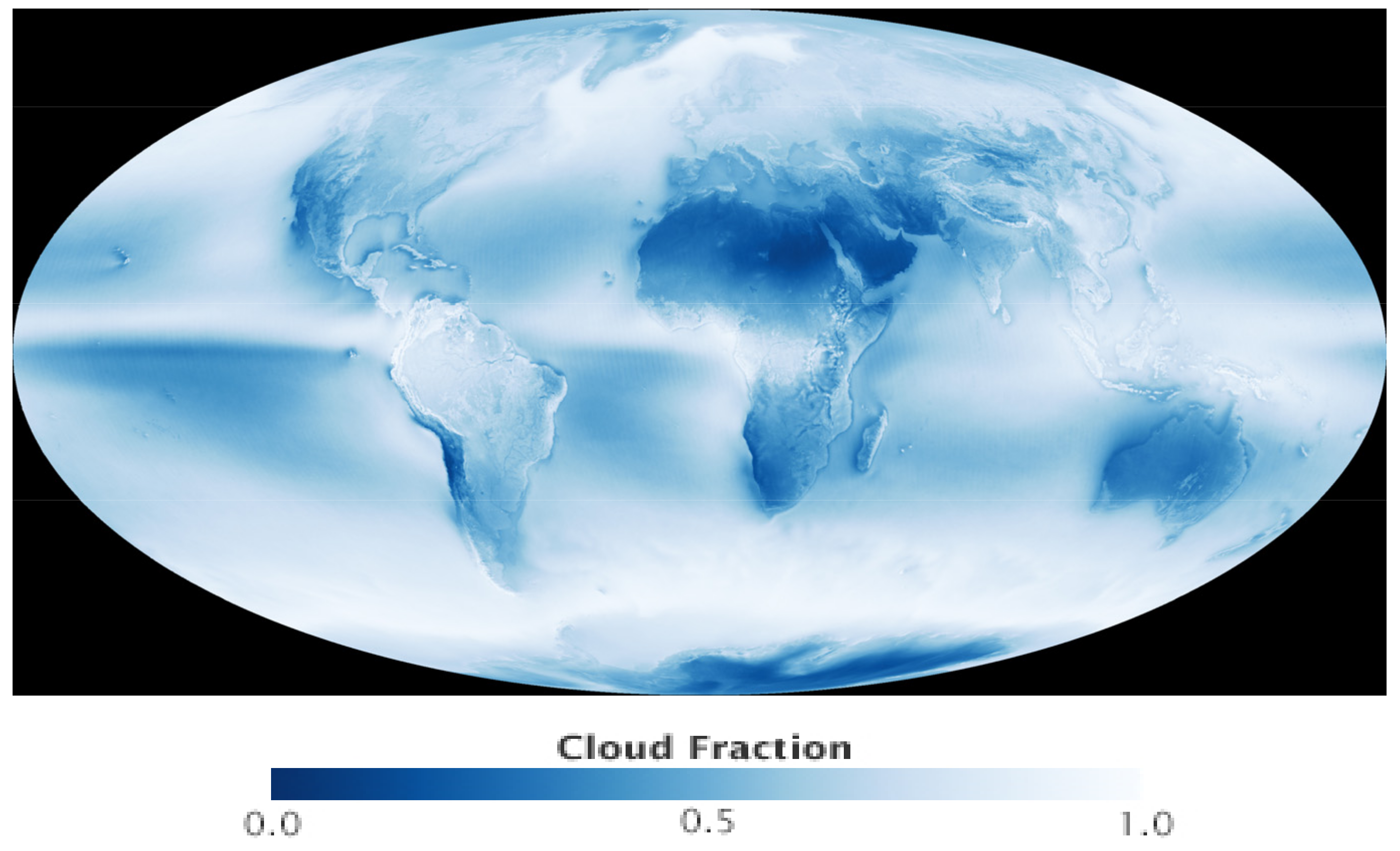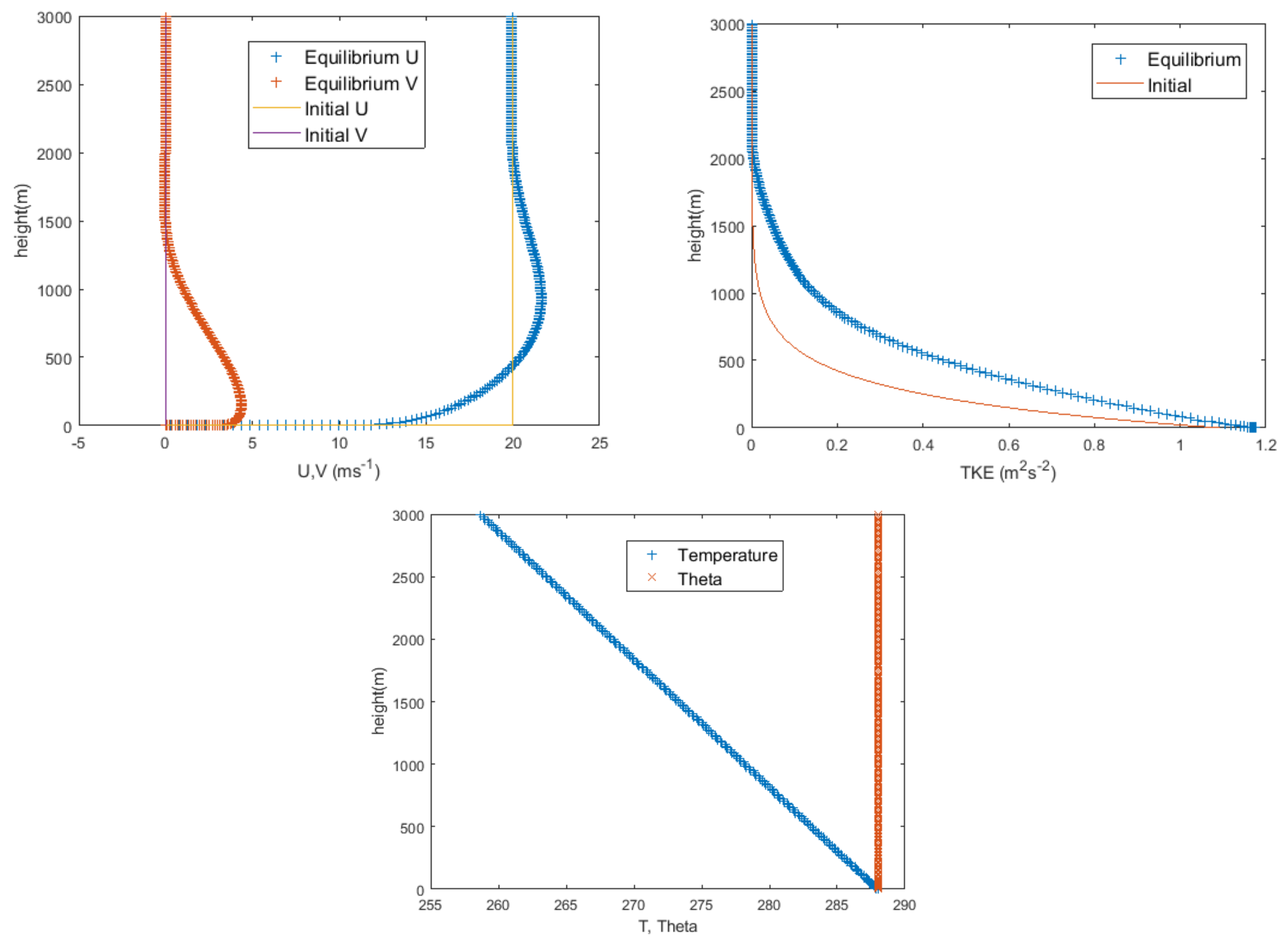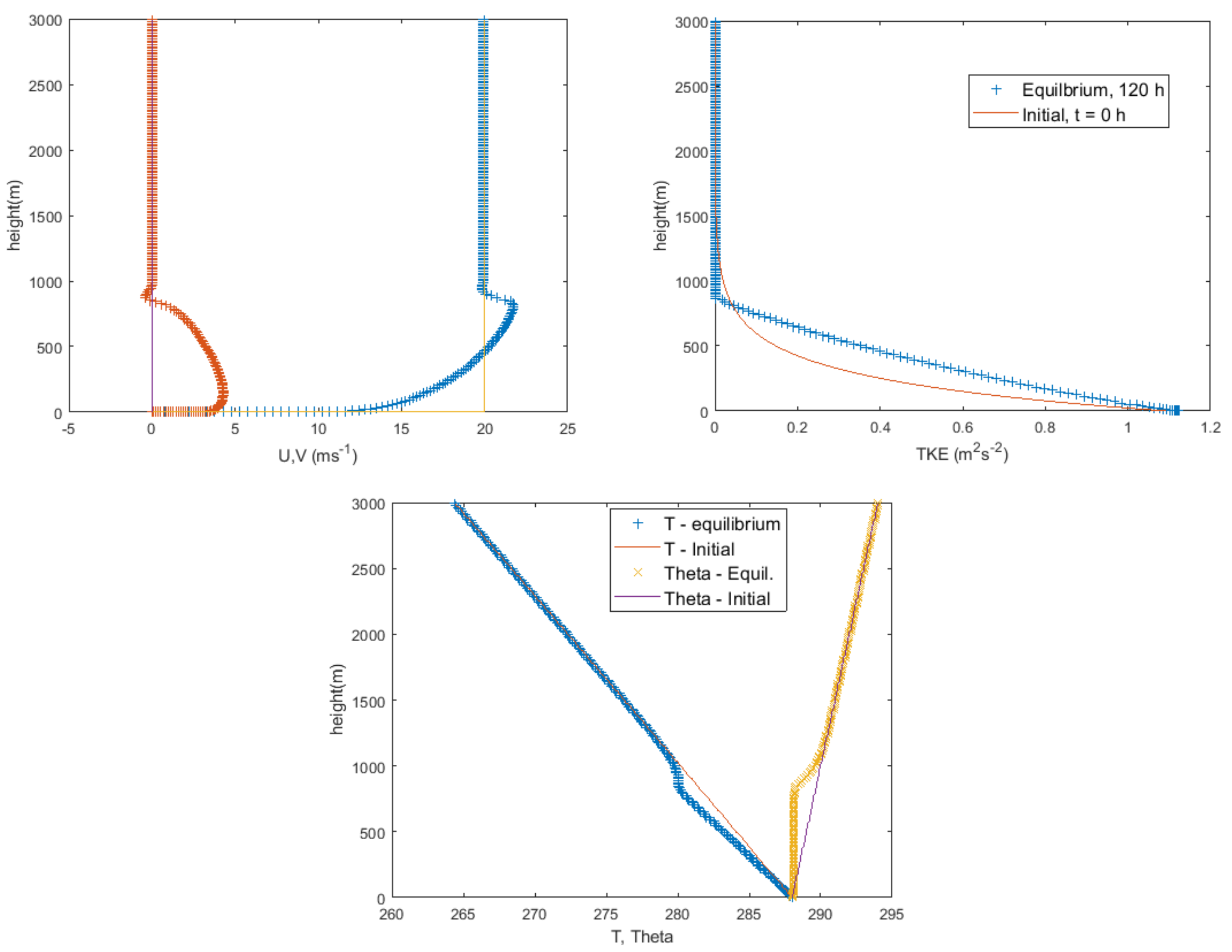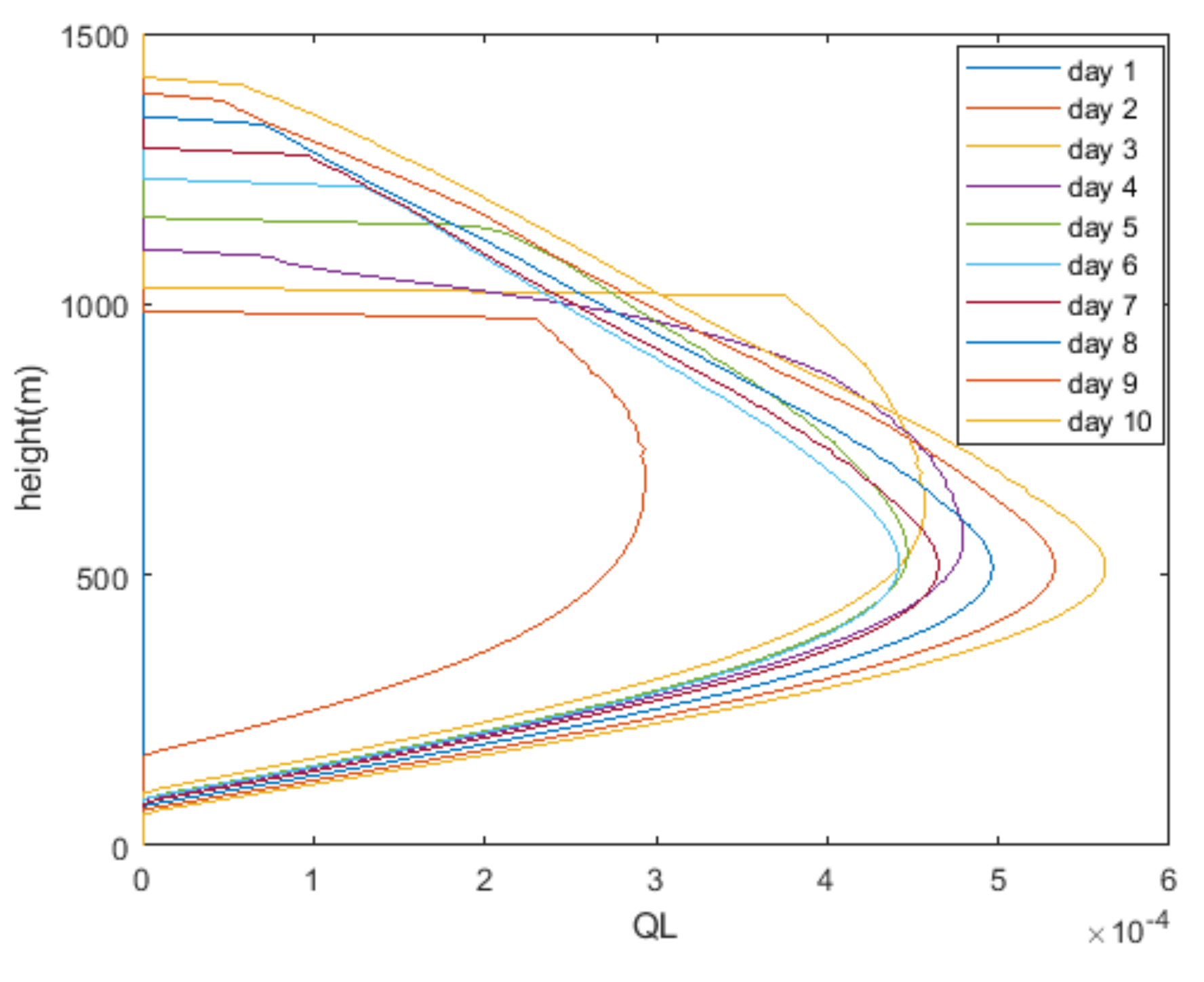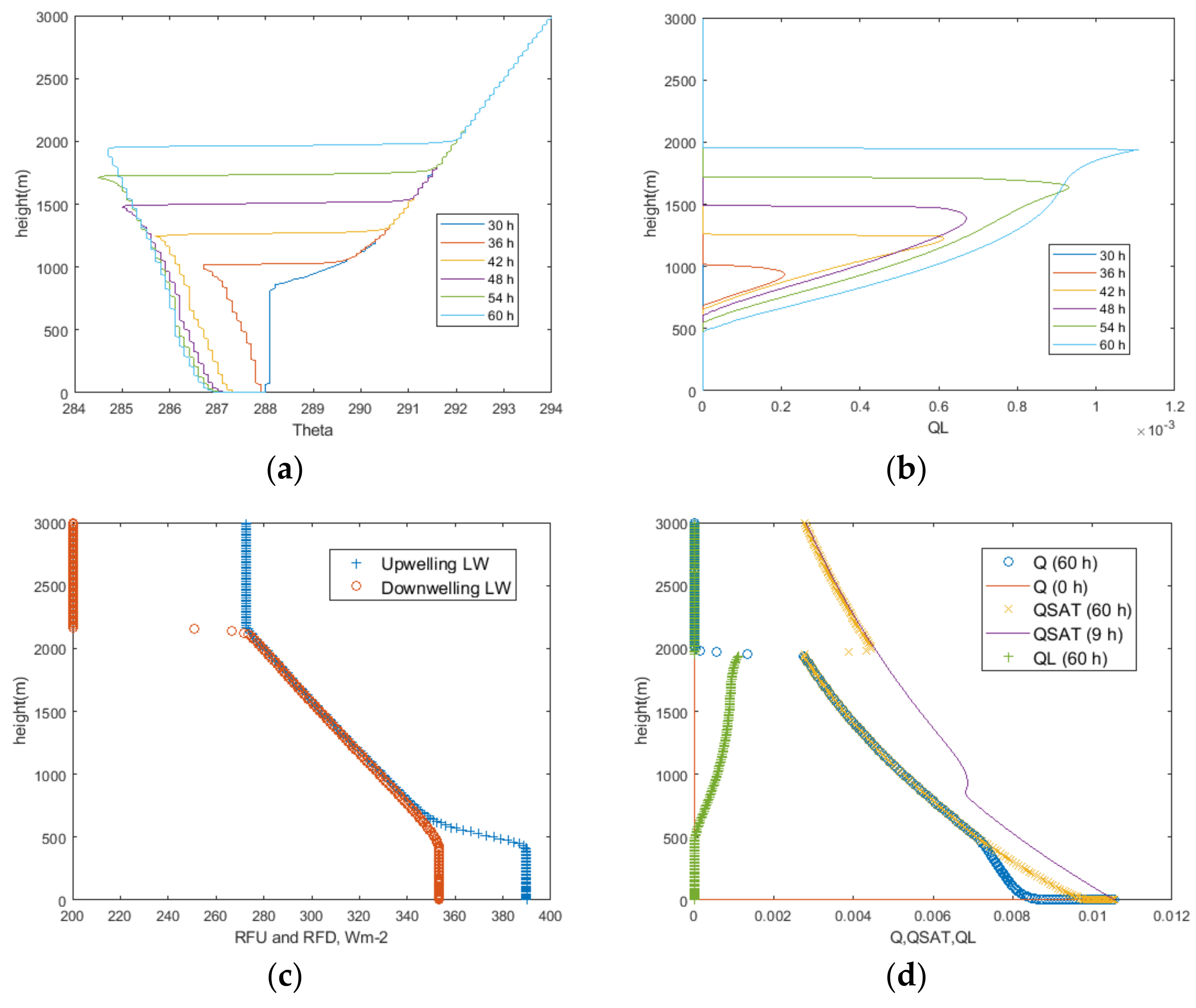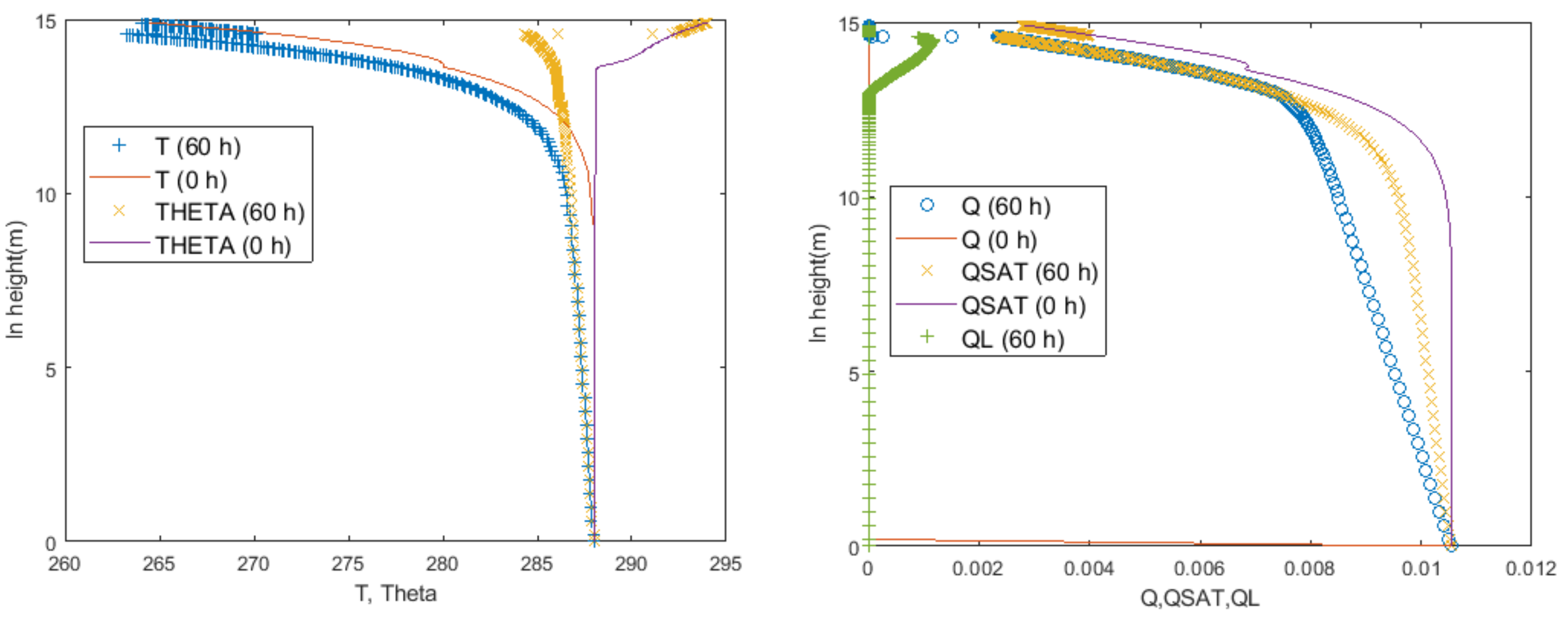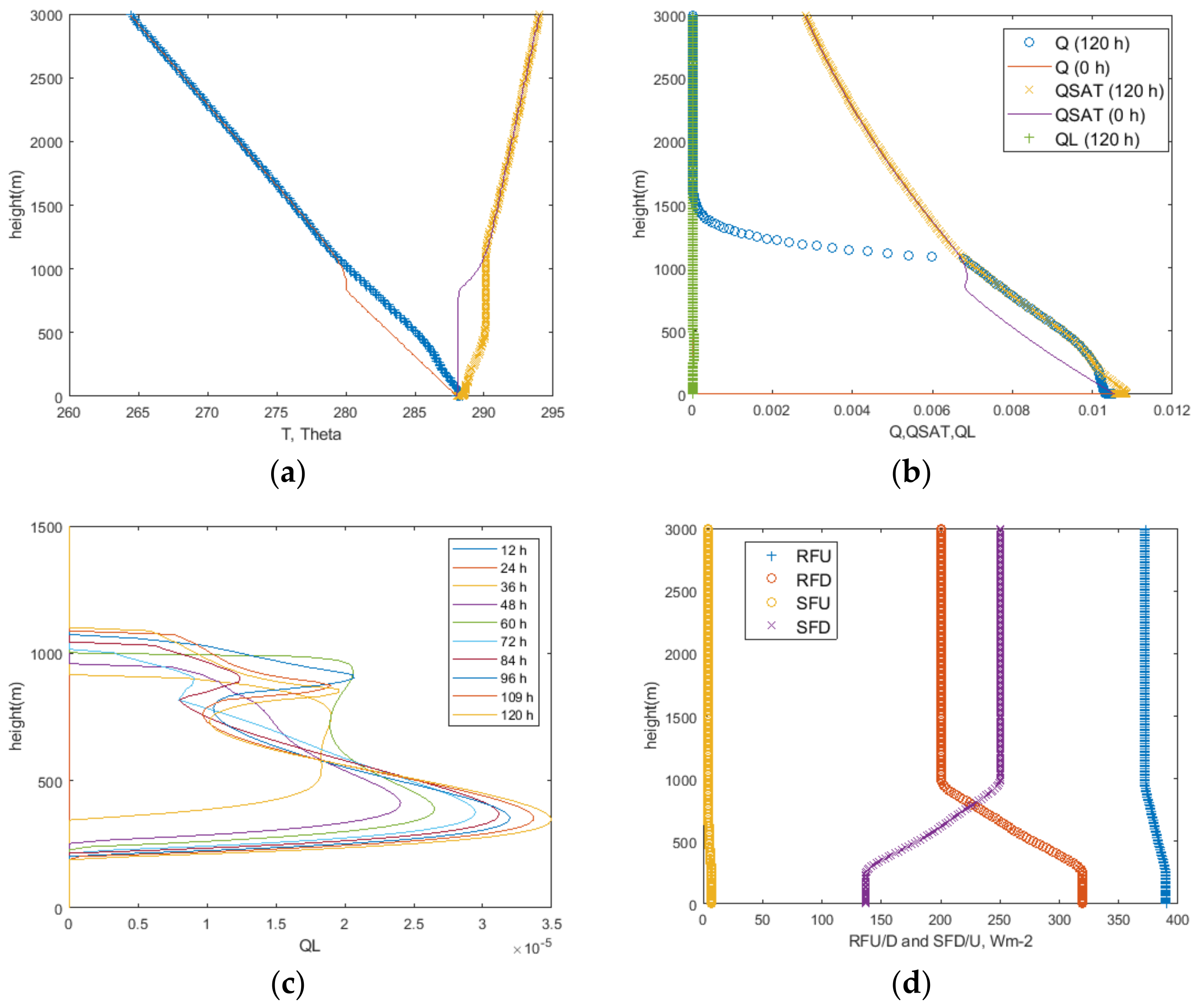1. Introduction
It is clear from
Figure 1 that cloud cover is high over mid-latitude ocean surfaces. In collaboration with the Fatima [
1] project, my group at York University has been studying and forecasting fog occurrence over the Canadian, coastal N. Atlantic, and over the Yellow Sea near Korea. Our early studies [
2,
3] with the forecast model, WRF, introduced the idea that the ocean water surface should be a sink for cloud droplets as well as a source for water vapor. In parallel with our WRF modeling, we have developed a separate boundary-layer cloud model.
It is important to stress that the model used here is a relatively simple “toy” model that we are using to explore processes involved in boundary-layer clouds and fog. While others are using 3D high resolution, large eddy simulation models, there is a lot that can be learned from simpler Reynolds-Averaged Navier–Stokes equation (RANS) models and idealized one dimensional situations with assumed horizontal homogeneity. In my group, we also use the Weather Research and Forecasting (WRF) model in both Single Column and 3D forecast modes. Within WRF, just the microphysics module (mp_thompson) has 5470 lines of code and tracking down exactly how things work is not easy! Warm clouds are easier than cold ones, and we also simplify vapor–droplet transitions. These are assumed to occur instantaneously, and we do not have droplet–drizzle–rain transitions—it is a simple model.
In a steady, well-mixed turbulent boundary layer above a water surface, potential temperature (
Θ) and water vapor mixing ratio (
Q) should, over time, become equal to surface values. The atmospheric boundary layer over the ocean is often capped by stable stratification above 1–2 km, and winds can be strong (of order 20 ms
−1). Sample profiles from Sable Island (WSA) are shown in
Figure 2. In this case, we see that clouds would have been present from about 500–1250 m with a stable layer at the top. Note that, sadly, the Sable Island radiosonde program ended in 2019 [
4].
With potential temperature,
Θ(
z)
≈ Θ(0), and unsaturated air with the dry adiabatic lapse rate,
Γ (= 9.8 K/km), we might expect
T(z) ≈ T(0) −
Γz, and as a result, the saturation vapor pressure and saturation mixing ratio will decrease with
z. In the plots above, the lapse rate is lower (~4 K/km), but the upward mixing of water vapor would still lead to condensation at some level. Since we are assuming saturation at the water surface, we might expect this to start as a surface-based cloud, but the water vapor is mixing upwards, and clouds will initially form higher up. There may be close to 100% relative humidity (RH) in the lower layers of the boundary layer, but the liquid water mixing ratio (
QL) is assumed to be 0 at
z = 0, and any liquid water would be diffused towards the surface. Katata [
5,
6] used similar ideas about droplet deposition over vegetation and forests.
Garratt’s (1992) text on the atmospheric boundary layer [
7] includes a chapter on the cloud-topped boundary layer or CTBL. It notes that, “The presence of clouds leads to considerable complications compared to a dry ABL (Atmospheric Boundary Layer) because of the important role played by radiative fluxes and phase changes.” There is an excellent discussion of properties and good examples of observations, but Garratt also includes the statement that “relatively few modelling studies have been made on the CTBL”. However, clouds within the boundary layer include fog, and the paper by Fisher and Caplan in 1963 [
8] covers both fog and stratus clouds. They develop a preliminary 1D turbulent diffusion model with water vapor and cloud liquid water included. They note the potential significance of radiational cooling but it was not included in their model. In their conclusions, they stress the need for field measurements on the vertical profiles of cloud liquid water content. Some have been made [
9], but more are still needed 60 years after their work.
Chapter 7 of Cotton and Anthes’s 1989 book
Storm and Cloud Dynamics [
10] discusses marine fog and, in particular, the OLW model [
11] from 1978. The OLW paper includes predictions of stratus clouds and fogs caused by stratus lowering as well as advective-radiative fogs. It is a RANS model and uses second-order closure, in comparison to our simple model with 1.5-order closure. Radiative flux divergence is included, and vapor–liquid droplet transfers are present within a model with total water and a “conserved” potential temperature (
θs) as the moisture-related variables. Lower boundary conditions appear to be based on mean surface values of total water mixing ratio and virtual potential temperature (OLW p 305), but it is not clear how liquid water droplets interact with the water surface. Our model will assume that they collide and coalesce so that the water surface is a sink for liquid water in the air (
QL(0) = 0). Figure 3 of the OLW paper shows maximum values of
QL at the surface in a warm surface fog situation (cold air advected over warm water). Our model would remove those surface droplets by coalescence with the underlying water surface.
There have been other model studies of fog and stratus clouds over water and land surfaces since then, including with NWP models, some single-column versions [
12], large eddy simulations [
13], and comparisons of both with observations. Work by Koraĉin et al. [
14], based on the Lagrangian advection of a 1D model, has similar features to our model described below, although details (see [
15,
16]) are different. Koraĉin et al. include a large-scale subsidence term, which they see as an important factor in fog caused by stratus lowering. In the coastal California context, they state, “Although the positive fluxes of sensible and latent heat at the air–sea interface are the factors that govern the onset of fog, sensitivity studies with the one-dimensional model indicate that these sensible and latent heat fluxes are of secondary importance as compared to subsidence and cloud-top cooling”. In parallel work on advection fog over cooling surfaces, we can form fog without subsidence.
These earlier papers have generally focused on simulating particular cases, and I am not aware of any high-resolution but simple PBL models presenting the basic situations over ocean water surfaces that we will study here.
2. A 1D PBL Model
Starting from the 1D PBL model (WT) developed with Wensong Weng [
17], we can add water vapor and liquid water and allow for transfers between them. We have also added radiative fluxes. In an idealized, horizontally homogeneous ABL and in the absence of radiative flux divergence and moisture, the WT Reynolds-averaged equations (RANS) describing the dynamics of the ABL can be written as shown below. In these equations, upper case symbols,
,
,
, etc., represent ensemble or Reynolds-averaged quantities. We assume that
W = 0. Lower case,
,
,
,
, etc., are turbulent fluctuations, and <…> represents an ensemble average. Technically, this is over many realizations of the flow, but in this horizontally homogeneous flow situation, it can be a horizontal average at fixed
z and
t.
Here,
RFDIV is radiative flux divergence and
LHT is a rate of latent heat release, or demand if negative. These are per unit mass of air. The specific heat of dry air at constant pressure,
cpa, starts as 1005 Jkg
−1K
−1 but includes adjustments for temperature, and
cp is for moist air accounting for mixing ratios and specific heats of water vapor and liquid water.
where the total mass of a volume containing 1 kg of dry air, as a mixing ratio, is
To these equations, we add conservation equations for water vapor,
Q and liquid water,
QL mixing ratios, defined in the atmospheric way as mass per unit mass of dry air. These are
Here Δ
Q is the rate at which water vapor is condensing into, or evaporating from, cloud droplets. It is dependent on the saturation mixing ratio
QSAT (T) and computed at each time step in a subroutine which is called “Adjust”. The latent heat added or subtracted in Equation (2),
LHT is simply
LΔ
Q, where
L is the latent heat of vaporization (2466 J/g at 288 K, but temperature variations are included).
Ws is the gravitational settling velocity of the droplets that are formed. Turbulent fluxes are represented by
where the eddy diffusivities,
Km,
Kh, etc., could differ. In addition, we use an equation for turbulent kinetic energy per unit mass (TKE,
E = 0.5 [
<u2> + <v2> + <w2>]),
Here
Ps and
Pb are shear and buoyancy production terms, and
ε is the rate of viscous dissipation, details in WT. The eddy diffusivities in this basic
E-l, 1.5 order closure are
Again, more details are in WT, but calculations here use α = 0.25, and a Prandtl number, Pr = 1.0. We use the same z0 for all quantities and ϕm is a function of z/Lo where Lo is the Obukhov length, based on local shear stress and heat flux values. In neutral stratification, Lo is infinite and ϕm = 1.
Lower boundary conditions on the water surface are U = 0, = Tsurf, the surface water temperature, Q = QSAT (Tsurf) and QL = 0. The surface can thus be a source of water vapor but is assumed to be a sink for cloud droplets as they collide and coalesce. Fluxes of momentum, heat, water vapor and liquid water evolve as a part of the solution and depend on the assumed roughness lengths. These can differ, z0m, z0h, etc., but are presently all set as z0 = 0.001 m.
Water droplets can be significant absorbers and emitters of long-wave radiation. For solar radiation, it is sometimes argued that cloud and fog droplets scatter rather than absorb solar radiation and the direct impact may be small. A layer of stratus cloud will, however, significantly reduce downwelling irradiance at the surface, and not all of the down welling energy is backscattered. One website,
https://www.foxweather.com/learn/does-fog-really-burn-off-dispelling-the-myth-of-combustible-clouds (accessed on 13 February 2024) states “People commonly refer to the dissipation of fog as ‘burning off’ but the reality is much less exciting”. Fog will forward scatter much of the solar radiation and, over land, will raise the surface and near-surface air temperatures, causing fog to dissipate. Solar radiation will heat up the upper layers of the ocean, but the increase in sea surface temperature is far less than for land surface temperatures, and, over water, the absorption of solar radiation by cloud and fog droplets may be more relevant. There appears to be limited information on the absorption of solar radiation by cloud droplets [
18].
To determine the radiative flux divergence, we need to model the four components of irradiance:
RFU and
RFD for long waves and
SFD and
SFU for solar radiation. All may be subject to absorption and there will be emission of long-wave radiation by cloud droplets. There will also be absorption and long-wave emissions by the air but for now, although included in the equations, these will be considered as small background effects compared with the local impact of cloud droplets. We also ignore backscattering and use a simple 2-stream (upwelling and downwelling) approach. With air density
ρa, and using mass absorption coefficients (
ka,
kw,
ksa,
ksw), ignoring backscattering, and with
σ as the Stefan–Boltzmann constant, we can write the transfer equations for irradiance as,
Here ρa is dry air density. Initially, we neglect clear air absorption (ka, ksa = 0), set the emissivity, ε = 1, and focus on absorption coefficients for cloud droplets (kw, ksw) with units of m2kg−1. A serious omission is the back scattering and multiple scattering of downwelling solar radiation (SFD) and the contribution to SFU. A more careful treatment of solar radiation is planned for future work.
Boundary conditions are needed on upwelling radiant fluxes at the surface and downwelling fluxes at the model top. These are specified in
Section 3.3, based on black body
RFU at the water surface and a relatively low albedo (0.05 in cases here) for solar irradiance. At the top boundary (300 m in this case), we specify a typical, clear sky value for
RFD (200 Wm
−2 here) and must specify
SFD. In realistic simulations, this will have a strong diurnal cycle, but in the test case considered in
Section 3.3, we simply set
SFD = 250 Wm
−2 and hold it constant.
The heating term added to Equation (2) is
Our microphysics assumes that condensation occurs instantaneously if the mixing ratio,
Q > QSAT(
T), the saturation value at air temperature,
T. Then
Q instantly reduces towards that saturation value with the excess becoming liquid water,
QL. This releases latent heat, raises
T, and modifies
QSAT so that some iteration is needed. An adjustment is made in the opposite direction when liquid droplets diffuse into a sub-saturated layer. A similar approach was used by Brown and Roach [
19], but no details were provided. Both transformations are assumed to take place at constant total pressure and with no external source or sink of heat. Our saturation adjustment involves some iteration and is illustrated in
Figure 3.
QL is not shown but could be computed via Equation (14) below.
The adjustment is between a non-equilibrium state (
Q1,
QL1,
T1) predicted after a time step (Equations (1)–(7)) with
Q1 ≠ QS1 to an equilibrium state with
Q2 = QS2, where
QSi = QS(Ti,
P), the saturation mixing ratio. Note that no adjustment is needed (Case 1) if
Q1 < QS1 and
QL1 = 0, but one is needed (Case 2) if
Q1 > QS1. In Case 4, we may find
Q1 < QS1 and
QL1 > 0, and liquid water will evaporate, cooling the air. It may also be possible (Case 3), with
Q1 < QS1 and
QL1 > 0, to evaporate all the droplets while
Q2 <
QS2. Our approach would then predict
QL2 < 0, and adjustments are made to correct for that. The essential feature of the adjustment is that heat per unit mass of the mass of the material undergoing the adjustment is conserved, i.e.,
where
cp1 and
cp2 are the specific heats of the dry air plus water vapor and liquid water in states 1 and 2. M is the total mass (dry air plus water vapor and liquid water) per unit mass of dry air, as in Equation (4). This is a constant during the adjustment. In the cases shown, our desired saturation adjustments correspond to the points of intersection of the solid green and blue lines with the black line corresponding to
QS(T). If we use the tangent
QS line and set
cp = cp1 in the
H = constant line, as in our initial estimates of state 2, we get the points of intersection of the dashed lines. Additional details are at
https://www.yorku.ca/pat/AdjustJan2024.pdf (accessed on 7 May 2024).
